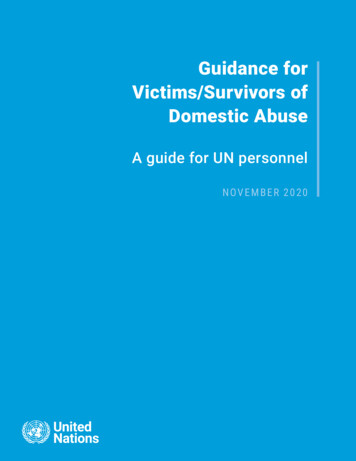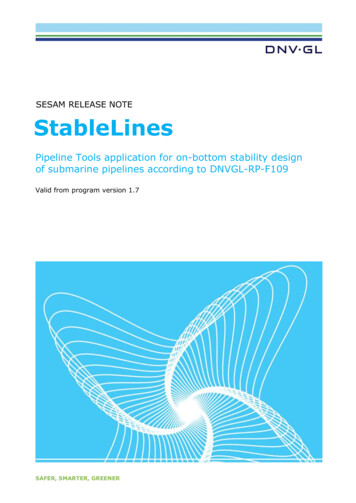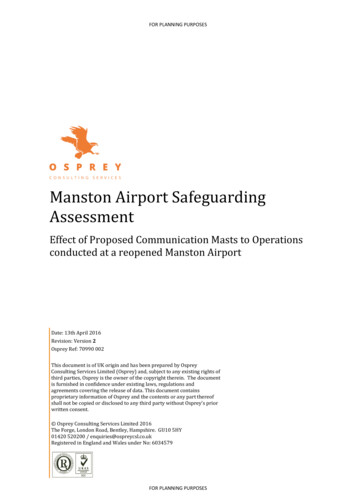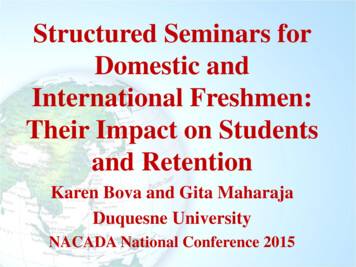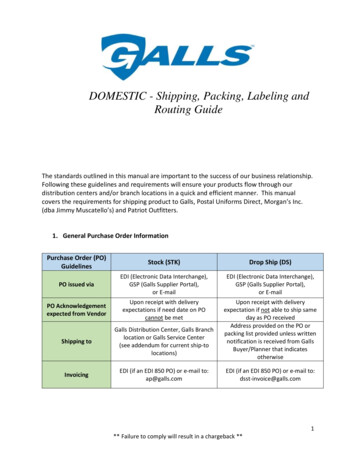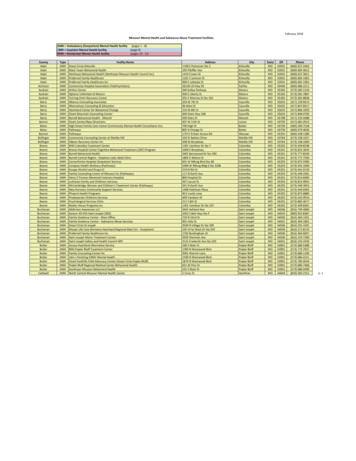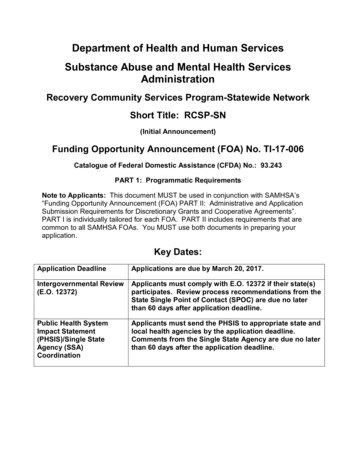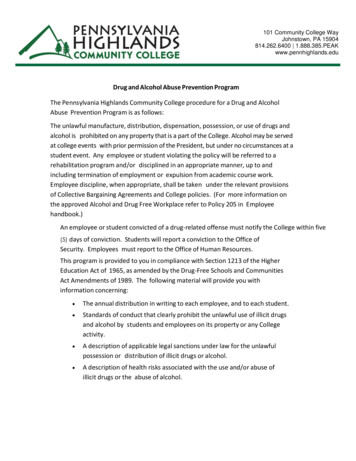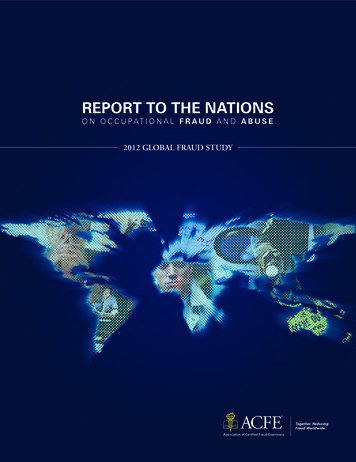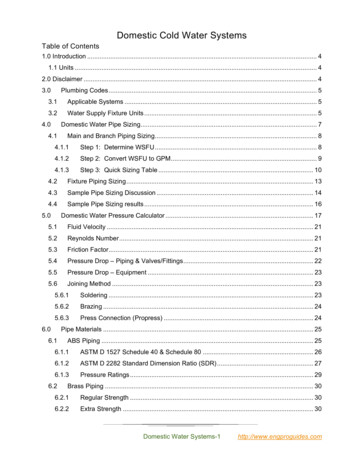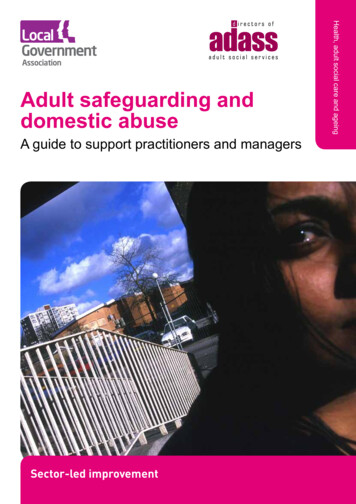
Transcription
A guide to support practitioners and managersSector-led improvementHealth, adult social care and ageingAdult safeguarding anddomestic abuse
ContentsBackground415Making the connections between adult safeguarding and domestic abuse2. What is domestic abuse? Who needs safeguarding? And how do they link together? 7Making the links with children’s safeguardingFamily and inter-generational abuse10Gender, safeguarding and domestic abuse10Case example 1123. Understanding the impact of domestic abuse13What is the impact of domestic abuse?13What are the additional impacts on adults at risk?13Case example 2154. Understanding why people remain in abusive relationships16What are the barriers to seeking help?16What are the additional barriers for people from a BME background?17What extra barriers may be faced by people in vulnerable circumstances?17Case example 3195. Working with people in vulnerable circumstances2920Accommodation20Independence and self-esteem20Confidence in services20Parenting21Substance misuse21Older age22Mental ill-health23Carers who harm and/or are at risk of harm23Exposure to an abusive environment25Adult safeguarding and domestic abuse A guide to support practitioners and managers
Forced marriageCase examples 4, 5 and 62527-286. Mental capacity, adult safeguarding and domestic abuse29Mental capacity to take decisions29An unwise decision or a decision taken under duress?29People who lack capacity30Case example 7317. Assessing and working with the risks of domestic abuse33Involving the person at risk33Using risk assessment tools and exercising professional judgement33Taking immediate protective measures34Independent domestic violence advisers (IDVAs)35Case examples 8 and 938-398. Working with perpetrators of domestic abuse40Assessment questions for perpetrators41People with care and support needs who perpetrate domestic abuse429. Making safe enquiries and defensible decisions43How to enquire safely about violence or abuse43Best practice in undertaking safe enquiry into domestic violence44Defensible decision-making4510. Using legal remedies and sanctions4611. What councils and organisations can do to support good practice4812. Resources and references50Appendix 1: Summary of legal remedies and sanctions52Appendix 2: Quick reference summary guide57Adult safeguarding and domestic abuse A guide to support practitioners and managers3
BackgroundThe guide was commissioned by the LocalGovernment Association (LGA), supportedby Association of Directors of Adult SocialServices (ADASS).The content was developed by Sue Lewis,Consultant for the LGA, in consultationwith Cathie Williams, Adult SafeguardingProgramme Lead.The references and resources it refersto, and much other information, canbe found on the adult safeguardinggroup on the Knowledge Hub: ingcommunityofpractice4AcknowledgementsKey parts of this guide draw significantlyon the multi-agency protocol produced byManchester Safeguarding Adults Board andManchester Safeguarding Children Board forlocal use – ‘Working Together To SafeguardAdults and Children from Domestic Abuse’.Thanks are also due to Wirral Adult SocialServices Department and partners for theirwork in testing out and advising on thecontent of the guide during its development.Finally, the many helpful comments andsuggestions sent by councils and otherpartners during the consultation phase havebeen very useful and are much appreciated.Adult safeguarding and domestic abuse A guide to support practitioners and managers
1. Making the connectionsbetween adult safeguardingand domestic abuseSafeguarding adults is a developing fieldof practice nationally and for all councilsand their partners, bringing with it manylayers of complexity and challenge. TheLocal Government Association (LGA) andAssociation of Directors of Adult SocialServices (ADASS) wish to support learningand development about what is best practiceas much as possible. Making the connectionsbetween adult safeguarding and domesticabuse is just one key area of development toaddress.This guide is for practitioners and managersin councils and partner agencies engagedin working directly or indirectly with peoplewho have care and support needs, whosecircumstances make them vulnerable, andwho may also be victims of domestic abuse.Its purpose is to help staff to give betterinformed and more effective support topeople who need an adult safeguardingservice because of domestic abuse.It addresses situations where an adult whohas care and support needs is being harmedor abused by an intimate partner or closefamily member in a way which could also bedefined as domestic abuse.In summary, the guide aims to: improve recognition and understandingof the circumstances in which adultsafeguarding and domestic abuse overlapand should be considered in tandem contribute to the knowledge andconfidence of professionals so that thecomplexities of working with people whoneed care and support, and who are alsoexperiencing/reporting domestic abuse arebetter understood, and better outcomes forpeople can be achieved as a result offer good, practical advice to staff andmanagers to ensure that older, disabledand mentally ill people in vulnerablecircumstances have the best support,advice and potential remedies if they areharmed or abused by a partner or familymember identify some of the organisationaldevelopments which can support bestpractice in this area.The practice suggestions in this guiderecognise that the priority for work inthis area is the safeguarding of childrenand adults. They do not replace existingsafeguarding children or adults procedures,and must be read and used in the contextof following your local procedures andprotocols.The complexity of work in safeguardingadults relates to safeguarding people’sright to life, and to a life free from inhumanor degrading treatment, together withsafeguarding people’s rights to privacy, afamily life and to make their own decisions,free from coercion or undue influence.Adult safeguarding and domestic abuse A guide to support practitioners and managers5
If you need guidance and support inimplementing local procedures or in usingthis guide, you should speak to yourmanager in the first instance.Alternatively, you can seek advice from asafeguarding lead/designated person in yourorganisation.1. Making the connectionsbetween adult safeguardingand domestic abuseQuick reference Follow your local policies, protocols andprocedures for safeguarding adults andchildren, and for domestic abuse. Use this guide to improveunderstanding of the issues anddevelop good practice.6Adult safeguarding and domestic abuse A guide to support practitioners and managers
2. What is domestic abuse?Who needs safeguarding? Andhow do they link together?Domestic abuse used to be defined in termsof ‘incidents’ of threatening behaviour:violence or other forms of abuse betweenadults who are or have been intimatepartners or family members. This definitionis now felt to be too narrowly focused onsingle incidents rather than complex andcontrolling patterns of behaviour which mayalso be physically non-violent. Followinga consultation by the government, thedefinition of domestic abuse has now beenreplaced, and the age range has also beenextended so that young people in violent andabusive relationships are included.From March 2013, the definition of domesticabuse is:‘Any incident or pattern of incidentsof controlling, coercive or threateningbehaviour, violence or abuse betweenthose aged 16 or over who are or havebeen intimate partners or family membersregardless of gender or sexuality.‘Controlling behaviour’ is: a range of actsdesigned to make a person subordinate and/or dependent by isolating them from sourcesof support, exploiting their resources andcapacities for personal gain, depriving themof the means needed for independence,resistance and escape and regulating theireveryday behaviour.‘Coercive behaviour is: an act or a patternof acts of assault, threats, humiliation andintimidation or other abuse that is used toharm, punish, or frighten their victim.’ **’This definition, which is not a legaldefinition, includes so called ‘honour’ basedviolence, female genital mutilation (FGM)and forced marriage, and is clear that victimsare not confined to one gender or ethnicgroup.’ (Government press release 2012)This can encompass, but is not limited to,the following types of abuse: psychological;physical; sexual; financial; emotional.’Examples of coercive and controllingbehaviour might be: the destruction ofproperty, isolation from friends, familyor other potential sources of support,preventing or controlling access to money,personal items, food, transportation and thetelephone, and stalking.Family members are defined as: mother,father, son, daughter, brother, sister andgrandparents, whether directly related, inlaws or step-family.It is recognised that the desire to exertpower and control underpins the majority ofdomestic abuse, which takes place, and thatabuse is usually inflicted to achieve this end.Adult safeguarding and domestic abuse A guide to support practitioners and managers7
The terms ‘domestic violence’ and ‘domesticabuse’ are often used interchangeably, butin this guide ‘domestic abuse’ is used as it isfelt to be a more inclusive way to describe arange of behaviours, which include violenceas well as all other forms of abuse.Voices from research and practice“My children were all very supportive. they all said don’t put up with it, but I justdidn’t know what to do, where to go, youknow, you don’t know how you can copeon your own. . for years you were told,any idea you had was stupid. And youknow, all of a sudden you realise you’renot stupid! When I finally felt I had toleave, I came down to my daughter’s,who lived in X. But I found my nerveswere so raw that, although I loved mygrandchildren to bits, I could not live withthem all the time. So I came here.”The adult safeguarding national policyagenda was set out in ‘No Secrets’(Department of Health 2000), andsafeguarding services have developedconsiderably since then.‘No Secrets’ defined a vulnerable adult as:‘a person who is or may be in need ofcommunity care services by reason of mentalor other disability, age or illness; and whois or may be unable to take care of him orherself or unable to protect him or herselfagainst significant harm or exploitation.’The term abuse in adult safeguardingincludes physical, sexual, emotional,psychological, financial, material, neglect,acts of omission, discriminatory andinstitutional abuse.8The term ‘adult at risk’ has in many placesnow replaced ‘vulnerable adult’ as a moreacceptable alternative proposed by the LawCommission, and is defined as:‘anyone with social care needs who is or maybe at risk of significant harm’.A new definition in the draft Care andSupport Bill 2012, currently being consideredby parliament, describes an adult at risk/inneed of a safeguarding service as someonewho: has needs for care and support (whetheror not the authority is meeting any of thoseneeds) is experiencing, or is at risk of, abuse orneglect as a result of those needs is unable toprotect himself or herself against the abuseor neglect or the risk of it.This guide also supports the social model ofdisability, which recognises that people aredisabled more by poor design, inaccessibleservices and other people’s attitudes thanthey are by their impairment. It is oftenthe circumstances in which a person findshimself or herself, or the way society isorganised, which determines vulnerability.For these reasons, ways to describe adultswho need safeguarding, used in this guideare:adult at risk; people living in vulnerablecircumstances; or people with care andsupport needs.These descriptions do not mean to implythat only people actually receiving servicesfrom local councils, or only people whohave previously met local Fair Access toCare (FACS) criteria, are entitled to beAdult safeguarding and domestic abuse A guide to support practitioners and managers
safeguarded. A self-funder (person who paysfor their own care privately) or someonewho has previously declined assessmentor services may meet the definition.Professionals should consider what theyknow about the person’s situation and needs,to decide whether a safeguarding referralmay be the right way forward.Making the links between adult safeguardingand domestic abuse is vital to make surethat people get access to the best help thatcan be offered, are treated with dignity andrespect, and are supported to achieve thebest outcomes for them.The guiding principles for working with adultswho need safeguarding are: empowerment prevention protection proportionate responses partnership working.In adult safeguarding as in all kinds of socialwork and social care support, the principleof empowerment means that outcomes areat the heart of everything that is done tosupport the person, and that is demonstratedthrough a ‘person-centred approach’ – whatdoes the person who has been harmed wantto happen?These principles are equally valid for workingwith people experiencing domestic abuse.Finding a common language and betterworking definitions that can be shared acrossdifferent contexts will also strengthen links(ADASS Advice Note April 2011 p.3). Termslike ‘victim’, ‘perpetrator’ and ‘survivor’ maynot be appropriate in adult safeguarding workgenerally but are appropriate when used inthe context of domestic abuse. ‘Financialabuse’ or ‘sexual abuse’ are terms commonlyused in safeguarding but many people preferthe more straight-forward descriptions oftheft, fraud, sexual assault or rape if thesecrimes have been alleged or committed.Making the links withchildren’s safeguardingWhere adult safeguarding and domesticabuse are being addressed, and childrenare involved or present as family members,professionals have a duty to refer tochildren’s services, using local protocols andprocedures, even if the adu
Adult safeguarding and domestic abuse A guide to support practitioners and managers 7 Domestic abuse used to be defined in terms of ‘incidents’ of threatening behaviour: violence or other forms of abuse between adults who are or have been intimate partners or family members. This definition is now felt to be too narrowly focused on single incidents rather than complex and controlling .
